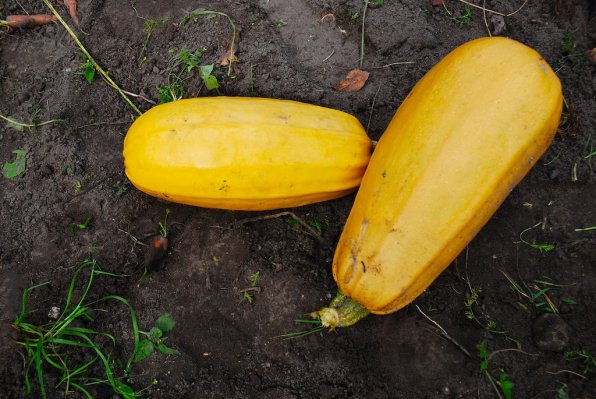The crisp fall weather brings with it a local harvest of winter squash, in all its fantastic, colorful variety. If you were lucky enough to grow up in a gardening or farming family, you probably know squash well. If not, you might recall it as a small, frozen paper box of orange mush or a bag of pre-cut cubes from the grocery store. It's possible you've never known the many charming personalities of winter squash, but it's not too late to meet them. Just visit your local farmers market or farm stand this fall, and try a variety you've never tried before.
You'll find butternut, buttercup, blue Hubbard, delicata, kabocha, banana (maybe), spaghetti and more. They're all beautiful to look at, and any will be a sweet, rich addition at the dinner table. Winter squashes are actually edible gourds, so a flair for decorating is in their genes. Go ahead and use them in a centerpiece, but don't leave them there too long. Eating squash is even more fun than looking at it.
Variety is the spice of life, of course. It's also the backbone of gardens and small farms everywhere and an important aspect of food security. By planting a persity of crops, the chance of all being lost to disease or bad weather is slim. Indeed, if more varieties of potatoes had been grown in the 1840s in Ireland, the devastating potato famine may never have happened. According to the Food and Agriculture Organization of the United Nations, 75 percent of the genetic persity of the world's food crops has been lost since 1900. Taking a chance on a variety of squash that you've never tried before is a great way to show your local farmer that you value crop persity.
Look for glossy squashes, with dark, rich color and unblemished skin. The darker orange the flesh is in color, the sweeter the flavor. It will keep well for a few months at 45 to 50 degrees. A dry basement works well. Don't store it for long in the refrigerator; the humidity will cause it to deteriorate pretty quickly.
Winter squash offers complex carbohydrates, lots of fiber, vitamin A, vitamin C, niacin, potassium, magnesium, iron and beta carotene. One cup of cooked squash has about 75 calories, two grams of sugar and two grams of protein. Go light on the butter, brown sugar and maple syrup; its strong flavor and natural sweetness shouldn't need much anyway.
Cutting your squash, once you have it home, may be your greatest challenge. The bigger the squash, the more dramatic the cutting. Use a large chef's knife or cleaver, and have a mallet or hammer ready to assist if necessary. For the giant blue Hubbard, you might even want to head outside with a hatchet. Some people even resort to dropping (that is, smashing) it on a hard surface. Whatever works!
Once cut, smashed or otherwise opened, the options are many. Peeling can be tedious, so be lazy and just bake your halved squash upside down at 350 degrees until it's soft (about 30 minutes). Scoop out the flesh and toss with butter, salt and pepper. Save the seeds for roasting later. Smaller varieties, like delicata and acorn, can be eaten with skin intact for even more nutrition, flavor and texture.
Try stuffing small squashes with savory stuffing or roasting chunks in butter and maple syrup. Sliced acorn squash, brushed with olive oil and rubbed with spices is delicious cooked on the grill. Complementary flavors for your squash creations include apples, cinnamon, nutmeg, ginger and maple syrup. For a classic stuffed squash, try onions, sage and thyme. If you're a carnivore, add a little local sweet Italian sausage and make it a meal.
Don't toss those seeds, either. Squash and pumpkin seeds are a high-fiber, nutritious snack. Just toss them with sea salt and olive oil and roast them at 350 degrees for about 10 minutes. Unless, of course, you save them for next year's garden.
Eleanor Baron lives, gardens, cooks, and writes in Concord, New Hampshire, and stalks area farmers markets for fresh, in-season produce. She has a special passion for the more unusual, less appreciated “underdog” vegetables. Visit her blog at nourishingwords.net for more ideas and inspiration on incorporating healthy habits into your life.




















